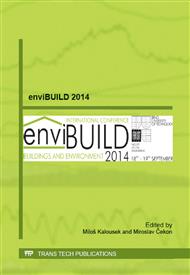p.307
p.311
p.315
p.321
p.325
p.329
p.333
p.337
p.341
Impact of Building Refurbishment on the Operative Temperature and PMV
Abstract:
Energy saving is one of the main priorities in the building sector. In the last years in Hungary different national programs were launched in order to improve the thermal properties of residential buildings. In case of building refurbishment 40-60% heating energy savings were expected. There were cases when the expected energy savings have not been met. The aim of this research was to see which the refurbishment impact is on the thermal comfort in a residential building. It was found the mean radiant temperature, the operative temperature and the predicted mean vote (PMV) decrease after building refurbishment.
Info:
Periodical:
Pages:
325-328
Citation:
Online since:
October 2014
Authors:
Keywords:
Price:
Сopyright:
© 2014 Trans Tech Publications Ltd. All Rights Reserved
Share:
Citation:


